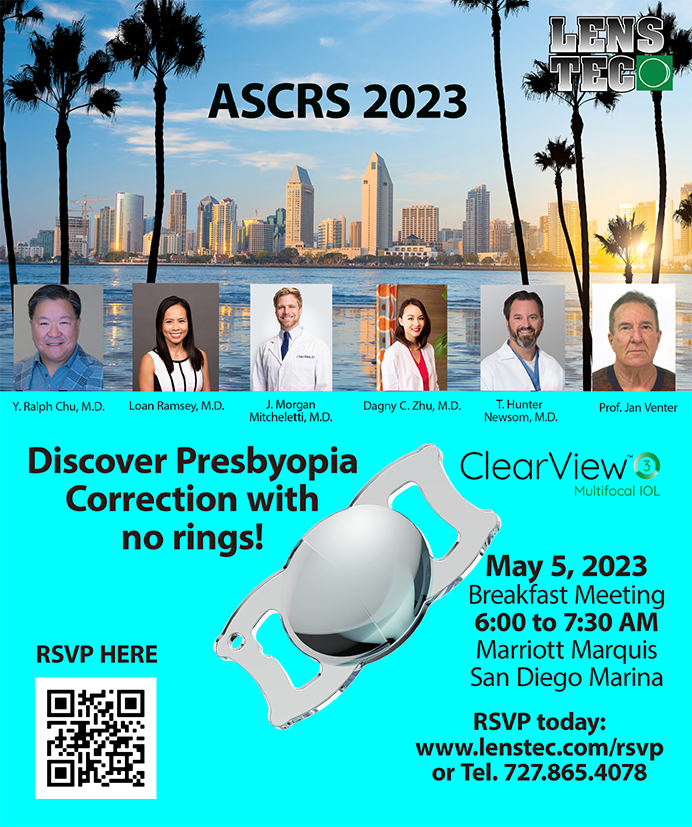One advantage of the new Acrysof Toric IOL (Alcon Laboratories, Inc., Fort Worth, TX) is that, unlike with limbal relaxing incisions, surgeons will not need to acquire a new skill set for managing astigmatism. They can use their customary technique for cataract removal and IOL implantation. Additionally, complications with the lens are rare and easily managed.
The Acrysof Toric IOL is based on the Acrysof Natural single-piece platform (Alcon Laboratories, Inc.) and is a foldable lens with a fully functional, 6-mm toric optic and Stableforce haptics (Alcon Laboratories, Inc.). The lens' acrylic material is highly biocompatible and has adhesive properties that, along with the haptic design, help to prevent rotation of the IOL after its implantation in the capsular bag. The posterior surface of the lens has added cylindrical power and axis markings to help the surgeon align the IOL after implanting it in the capsular bag.
SURGICAL IMPLANTATION
Altering Cataract Surgery
All cataract surgeons will quickly become comfortable with implanting the Acrysof Toric IOL. Only minor modifications to a surgeon's routine cataract procedure are required for success. Areas where modifications are necessary include (1) the IOL calculation for cylindrical power and axis of placement, (2) the marking of the eye, and (3) the on-axis placement of the IOL.
Power Calculation
Selecting the appropriate lens model for a particular patient begins with determining the required spherical IOL power. Surgeons should use the method and formulae they prefer for conventional monofocal IOLs to determine each patient's spherical power requirements. They should then use the online Acrysof Toric IOL Calculator (http://www.acrysoftoriccalculator.com) to assist in the selection of the correct model and optimal axis location within the capsular bag. The calculator is unique in that it compensates for expected surgically induced astigmatism in the calculation of both the IOL's power and the axis' location?features that allow for more precise surgical planning.
Marking the Eye
The marking procedure is done in two steps. First, the surgeon places reference marks at the 3- and 9-o'clock meridians at the limbus, either in the preinduction room or in the OR. This step should be done with the patient sitting upright to avoid the effect of cyclorotation when the patient moves to a supine position for the cataract procedure. The surgeon then performs a standard capsulorhexis, hydrodissection, and phacoemulsification. After cataract removal, using the reference marks, the surgeon places axis marks to delineate the steep axis of astigmatism upon which the IOL should be aligned.
Aligning the IOL With the Axis
Precisely aligning the IOL with the predetermined axis of placement involves gross alignment, viscoelastic removal, and final alignment. The first occurs after the IOL's implantation but before it has unfolded fully in the capsular bag. The IOL should be rotated to a point that is 15° to 20° counterclockwise of the final axis' location. The surgeon must ensure that the IOL does not rotate beyond the final axis during the viscoelastic's removal. It is important to remove all of the viscoelastic, including on the posterior side of the lens, because remnants could cause rotation of the IOL postoperatively.
There are various techniques and instrumentation that a surgeon may use to achieve precise on-axis alignment of the IOL. My preferred technique is to use a silicone I/A tip and a Sinskey hook (Katena, Inc., Denville, NJ) through the sideport incision to achieve gross alignment. I then use the Sinskey hook to hold the implant in place while I remove the viscoelastic with the silicone I/A tip. Then, I use the Sinskey hook once again to carefully nudge the IOL into the final alignment with the axis. Regardless of which surgical technique a surgeon chooses to employ, the precise alignment of the IOL is critical to achieving excellent outcomes with the Acrysof Toric IOL.
SURGICAL OUTCOMES
The lens must remain rotationally stable within the capsular bag to maintain its visual performance. The Acrysof Toric IOL remains secure in the capsular bag as a result of the Stableforce haptic design and the adhesive nature of the acrylic material.
An unpublished, randomized, prospective, multicenter study that included 494 patients compared the Acrysof Toric IOL with the monofocal Acrysof model SA60AT (Alcon Laboratories, Inc.). Follow-up data included the unilateral implantation of 211 Acrysof Toric IOLs and 210 control lenses. The Acrysof Toric IOL exhibited excellent rotational stability with an average revolution of less than 4° from its initial placement through 6 months postoperatively.
Additionally, the Acrysof Toric IOL provided significantly improved spectacle freedom for distance vision compared to the control. In the clinical study, 60 of patients who underwent unilateral Acrysof Toric IOL implantation achieved spectacle freedom for distance vision. In the same study, a subset of patients implanted bilaterally achieved 97 spectacle freedom for distance vision.
COMPLICATIONS MANAGEMENT
Happily, complications with the Acrysof Toric IOL are rare, and, when they do occur, they are easily managed. One potential problem is that the implant may rotate beyond the desired axis of alignment during the removal of viscoelastic. In such cases, the surgeon can reinflate the capsular bag with additional viscoelastic, reposition the implant to achieve gross alignment, and then proceed through the remainder of the procedure to attain final alignment. It is important to note that the lens cannot be easily rotated counterclockwise without the risk of damaging or ripping the capsular bag.
Any errors in IOL power calculations or misalignment of the IOL during surgery may necessitate the IOL's repositioning or exchange.
IN SUMMARY
I believe that excellent results can be achieved with the Acrysof Toric IOL with minimal modification to ophthalmologists' surgical technique. Because of its rotational stability and advanced IOL calculator, this new lens enables surgeons to correct astigmatism precisely and achieve distance-vision spectacle freedom for more patients.
Edward J. Holland, MD, is Director of Cornea at the Cincinnati Eye Institute and Professor of Ophthalmology at the University of Cincinnati in Ohio. He is a paid consultant to Alcon Laboratories, Inc. Dr. Holland may be reached at (859) 331-9000, extension 4121; eholland@fuse.net.


